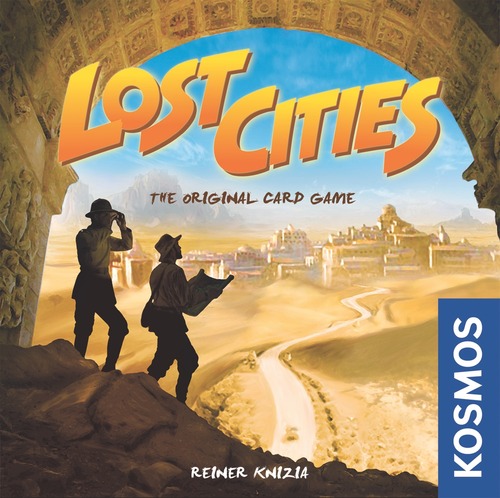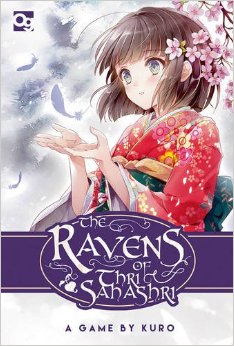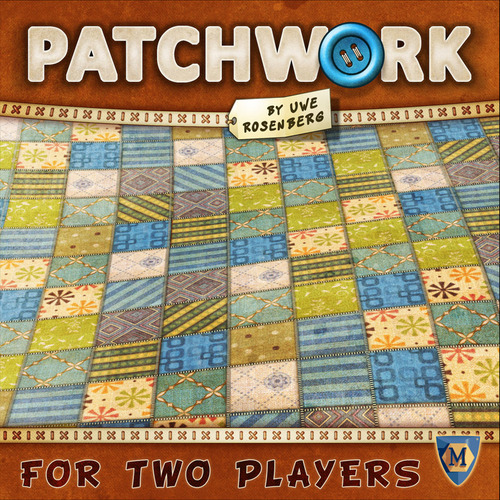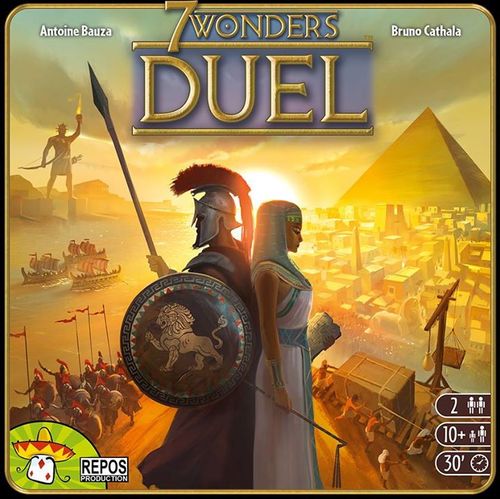Gamers' Advisory: Board Games for Two
This article was first published on the Board in the Library blog. Republished with permission.
Board games are picking up steam in libraries and "the golden age of board gaming" is going strong. Two years of having a circulating board game collection at the Bucks County Library System (PA) has affirmed this and a few things for me—you don't need a large group to play board games, the games don't need take up much space, can be easy to learn and can easily demo at a circulation desk.
One of the most frequent gamers' advisory questions I get is "What would be a good game to play with my partner?" To answer this I'm going to examine some of my favorite board games for two and only two people. There are a few basic criteria I'll follow when selecting games. First, only games that play with two people exclusively will be examined. While games with a higher player count like Pandemic and Stone Age won't make the list, they are certainly wonderful games for two people. Games also have to have a simple set-up and can be played quickly excluding larger, bulky war-games and strategy games are out.
These are games that play while dinner is cooking (*ahem* being delivered) or after the small human has been put to nocturnal rest. There isn't time for games with elaborate set-up and reams of rules to learn or lots of investment to play. So many of the popular "living" or collectible cards games are also excluded. The games below you can learn and play in 30-45 minutes and will provide just enough decision space to encourage repeat play.
Beginner
These games have simple rules, easy game play and limited strategic depth for entry level gamers. Great games to begin with and will become perennial favorites.
 Jaipur (30 minutes, Ages 12+, Asmodee)
Jaipur (30 minutes, Ages 12+, Asmodee)
Jaipur is my favorite two player game. In Jaipur, each player is one of the two most powerful traders in the capital city of Rajasthan, India—Jaipur. You trade in camels, spices, gold, silks, leather and jewels. Each player gets a hand of cards representing the different goods. In the center of the table is a market where five cards are displayed. You have a simple choice to make: You can take a single good for free from the market, exchange any number of goods from your hand for goods in the market, take all the camels, or you can sell sets of goods of one type from your hand to gain tokens. These tokens provide the points that will win you the game. Be cautious (but not too cautious) because the worth of the tokens declines as the game continues rewarding early sales. However, there are also bonuses to gain if you collect and sell large commodities.
Jaipur is a pleasantly tense game of press-your-luck, careful planning and just enough luck that new players have a good chance of doing well.
 Lost Cities (15-30 minutes, Ages 10+, Thames & Kosmos)
Lost Cities (15-30 minutes, Ages 10+, Thames & Kosmos)
Just a tick more complicated but a bit faster than Jaipur is Lost Cities. In this card game, two explorers are planning expeditions and playing cards to ensure their success in order to score points and win. Players start with a hand of eight cards of five different colors (each color is a different expedition) each numbered from two to ten. Once players commit to an expedition, they automatically lose 20 points (to cover the overhead costs, you know!) and then have to delve deeper and deeper into the expedition by playing cards of the same color increasing in value to make a profit. Investment (also called "Handshake") cards can also be played first to act as a multiplier when you score at the end of the game.
The turns are simple, on your turn you play one card to an expedition or discard. Then you draw a card. Be careful! Once you commit to an expedition you must make sure it is profitable by playing cards as high as possible. At the end of the game you add up the value of each expedition's cards, subtract the 20 points for each and apply any investment cards.
The gameplay of Lost Cities is quick and the theme is very light, making it perfect for new and emerging gamers. Anyone with a basic understanding of building runs in Gin Rummy will understand Lost Cities in no time.
 Hive (20 minutes, Ages 8+, Asmodee)
Hive (20 minutes, Ages 8+, Asmodee)
Hive is a fast playing abstract strategy game where two players maneuver their pieces around each other in order to capture their opponent's queen . . . bee. Sound familiar? The catch is that you are using bugs and there is no board. Each player starts with 11 tiles of the same color; the first player places their first tile on the table the second player then places their first. Then each player takes turns either moving one existing tile or placing one new tile.
There are a few placement rules. The queen bee must be placed within the first four turns and any new pieces must be connected to at least one existing piece and can only be added adjacent to tiles of their same color. After you build your hive (that mass of bugs in front of you), you need to keep it together so you can't move so that it breaks in two. The second rule is you can't move a piece if by moving it you would break the hive. The game ends as soon as one player's queen has been entirely surrounded by pieces of any color. Similar to Chess, different insects move in different ways—the grasshopper jumps over any number of insects, ants can move around the edges of the hive, the queen bee can move one space at a time, the beetle also moves one space at a time but it can clamber and climb on top of other insects, and the spider moves three spaces. As the game progresses the hive morphs and along with it. So the hive morphs constantly.
Similar to Chess, this Mensa Select award winner requires some memory of how each piece moves but unlike Chess, there is the added strategic element of building your hive before going out to hunt the enemy queen. Hive plays in less than 20 minutes so losses don't . . . sting.
Intermediate
These games have more complexity and strategy for those emerging gamers who have a couple of games under their collective belts (or the just those that seek some excitement).
 Ravens of Thri Sahashri (45 Minutes, 12+, Osprey Games)
Ravens of Thri Sahashri (45 Minutes, 12+, Osprey Games)
In The Ravens of Thri Sahashri one player takes the role of Ren, a young girl in a coma, and the other player takes the role of Feth, a young psychic with the ability to reach deep inside her subconscious and bring her back. This interaction between the two players centers around the Feth player setting out an array of cards for the Ren player to have the best chance at completing sets of cards in front of her.
Each game of Ravens is made up of three "dreams." At the beginning of the first dream, the player taking the role of Ren will draw four cards and place them face down in a column in front of her. These are her Heart Cards and only she can see them. Each card has a numeric value of one through five, one of five colors, and shaded areas (meant to represent the hurdles or blocks to Ren’s memories). Then each round of the dream, the player taking the role of Feth will draw cards from the central deck to build an Atman in the center of the play area. This Atman (or True Self) represents the fragments of the Ren's memories. Ren can then choose one card from the Atman and place it in next to her heart cards. The hearts cards represent a poem (a dodoitsu—or poem with four lines of 7, 7, 7, 5 syllables). Ren can work to complete one line at a time. Only moving to the next line when the previous one is complete by a set of cards adding up to seven (or in the case of the last line of the dodoitsu, five).
This card game is something special. Deep, complex and very, very difficult for players to win. But the wins are so very rewarding as each will unlocks new game elements; held within three sealed envelopes which come with the game.
 Patchwork (30 Minutes, Ages 8+, Mayfair)
Patchwork (30 Minutes, Ages 8+, Mayfair)
It's a quilt off! In Patchwork, two players compete to build the most aesthetically pleasing (through the application of points) patchwork quilt. Each player has a personal quilting grid, all of the tetris-like patches are laid out in a circle and a spool is placed on the starting tile. Each patch has a cost in buttons and time and an income that can be collected at the end of your turn. Each player starts the game with five buttons.
On a turn a player may purchase a patch within three spaces of the spool, pay the cost in buttons and move the spool unoccupied spot. That patch is then placed on your board and your advance to a time token. Like tetris, you want to plan ahead and fit your patches as close as possible to other patches. If the time token is behind your opponent’s token, you get to go again. If you are running low on buttons, you can pass instead of buying a patch, which allows you to collect buttons from the supply. The game ends when both player's time tokens reach the end of the time track, the quilting circle breaks up and each player scores their quilt.
With rules that can be explained quickly, a mechanism that looks shockingly like Tetris, Patchwork is a fulfillingly strategic but non-confrontational puzzle for players.
Expert
These games will blow your mind with even more complexity and will appeal to fully fledged, merit-badged and honored board gaming humans (or those that prefer to start with a challenge).
 7 Wonders Duel (30 minutes, Ages 10+, Asmodee)
7 Wonders Duel (30 minutes, Ages 10+, Asmodee)
In 7 Wonders: Duel players are developing competing civilizations by collecting resources, erecting wonders of architecture, developing science and technology, and waging war. The game is arranged into three ages (each age is a deck of cards), which are arranged in a pyramid with some cards face-up and some cards face-down by rows. Players then take turns choosing a card and using it in one of three ways. They can build a building by paying the cost and placing the card in front of them, discard the card for money, or use the card to erect a wonder. Each card has a cost to build and then an effect which is applied. Through selection of cards, you can win through warfare (by collecting red cards and moving your army towards your opponent's city), through science and technology (by collecting sets of green cards), or through commerce (by collecting resources and gaining more points than your opponent).
There is a delightful combination of luck, strategy and interaction in 7 Wonders: Duel. You can win through science, warfare or commerce which requires players to keep a tactical eye on the cards and what their opponent is planning. Unfortunately, it requires more set-up than the other games on this list and will take a few plays to understand the iconography on the cards.
John Pappas is Library Manager, Bucks County Free Library (PA). Pappas wrote a six-part series for WebJunction on modern board games an their presence in the library space. Read the series here: Part One | Part Two | Part Three | Part Four | Part Five | and Part Six.
